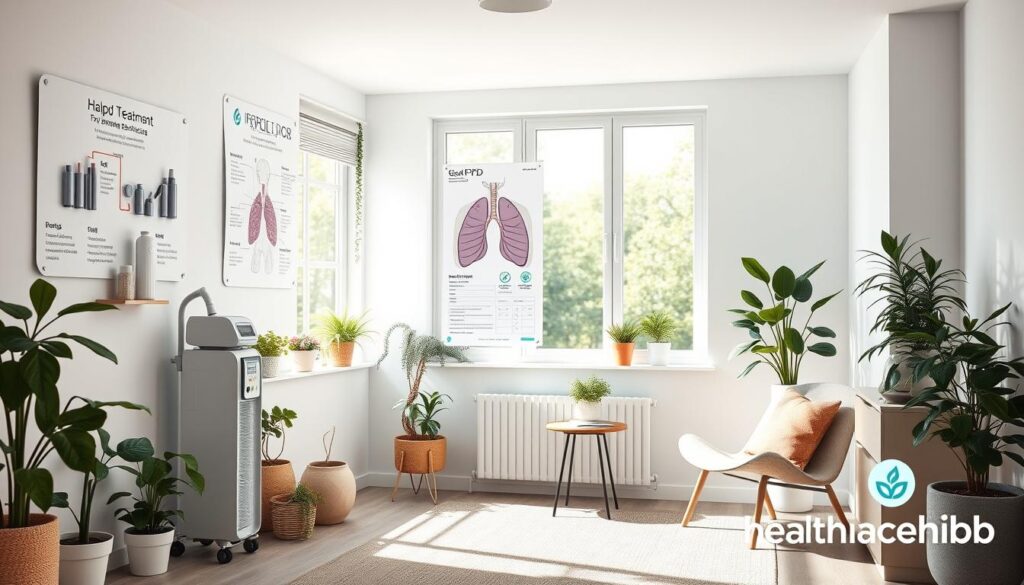Chronic Obstructive Pulmonary Disease (COPD) affects over 16 million adults in the United States. It’s an umbrella term for inflammatory respiratory conditions like emphysema and chronic bronchitis. Effective COPD management is crucial for enhancing respiratory well-being and extending overall lifespan. This article provides comprehensive strategies for COPD management, including medication, lifestyle modifications, and environmental considerations to improve breathing and quality of life.
Key Takeaways
- COPD affects over 16 million Americans, with up to a quarter of patients having never smoked.
- Effective COPD management strategies can improve respiratory health and quality of life.
- Medication, lifestyle changes, and environmental adaptations are essential components of COPD management.
- Occupational therapists and support services can help COPD patients manage daily activities.
- Pulmonary rehabilitation programs offer comprehensive care for COPD patients.
Understanding COPD: Essential Facts and Impact on Daily Life
Chronic Obstructive Pulmonary Disease (COPD) is a long-term lung condition affecting millions globally. It includes emphysema and chronic bronchitis, which block airflow. This makes breathing harder over time.
Types of COPD Conditions
COPD has two main types:
- Emphysema – Damages air sacs in the lungs, making it hard to breathe out.
- Chronic Bronchitis – Causes inflammation and mucus in airways, leading to coughing and breathing issues.
How COPD Affects Respiratory Function
COPD limits airflow, making it hard for lungs to inhale and exhale well. This leads to shortness of breath and other symptoms.
Common Symptoms and Warning Signs
Common COPD symptoms include shortness of breath and a chronic cough. Wheezing, chest tightness, and more mucus are also signs. These symptoms get worse over time, so early detection is key.
“COPD is the fourth leading cause of death worldwide, causing 3.5 million deaths in 2021, approximately 5% of all global deaths.”
COPD Management: Treatment Options and Strategies
Managing COPD requires a mix of treatments to control symptoms, prevent flare-ups, and boost lung health. Patients can choose from various treatments like medications, pulmonary rehab, and lifestyle changes. These aim to improve life quality and slow disease growth.
Medication Therapies
Inhalers, including quick-acting and long-lasting bronchodilators, are key for easier breathing. Steroid inhalers might be added if breathing issues still exist. Oral drugs like theophylline and mucolytics help when inhalers don’t work well enough. Steroid tablets and antibiotics are for severe cases and infections.
Pulmonary Rehabilitation and Airway Clearance
- Pulmonary rehab, with exercise and education, boosts fitness and well-being.
- Techniques like chest physiotherapy and breathing exercises clear mucus, making breathing easier.
Supplemental Oxygen and Ventilation
For those with low blood oxygen, long-term oxygen therapy can greatly improve life. Portable oxygen helps during activities. Non-invasive ventilation (NIV) supports breathing during severe attacks.
Though COPD can’t be cured, treatments can manage symptoms, slow disease, and reduce flare-ups. A tailored treatment plan from a healthcare provider is key to managing COPD and enhancing well-being.

Medication Essentials: Bronchodilators and Corticosteroids
Managing chronic obstructive pulmonary disease (COPD) often requires a mix of medications. Bronchodilators and corticosteroids are key. They help ease symptoms, boost lung function, and cut down on flare-ups.
Proper Inhaler Technique
Inhaled meds are vital for COPD care. Using inhalers right is key to their success. Patients need to learn how to use them correctly. This ensures the meds reach the lungs properly.
Healthcare providers should check and teach inhaler use often. This helps patients get the most from their treatments.
Managing Medication Schedules
Sticking to medication schedules is vital for COPD control. Patients must take their meds as directed. This could be daily or as needed.
Talking regularly with doctors helps solve any issues with taking meds. It ensures patients stay on track with their treatment.
Common Side Effects and Solutions
While most COPD meds are safe, side effects can happen. These might include dry mouth, tremors, or a faster heart rate. It’s important for patients to know about these risks.
Working with doctors can help manage these side effects. Sometimes, changing the dosage or type of medication can help.
| Medication Type | Key Benefits | Potential Side Effects |
|---|---|---|
| Bronchodilators |
|
|
| Corticosteroids |
|
|
Understanding COPD meds is key. Patients and doctors can work together. This way, they can create a treatment plan that works best for each person. It aims to maximize benefits and minimize side effects.
Lifestyle Modifications for Better Breathing
People with Chronic Obstructive Pulmonary Disease (COPD) can improve their breathing and health by making lifestyle changes. Quitting smoking is key, as it’s the main cause of COPD. It’s responsible for up to 43% of deaths from lung diseases.
Regular exercise, tailored to each person’s abilities, can boost lung function and endurance. Studies show that exercise can improve tolerance and quality of life for those with mild to moderate COPD. Breathing exercises, like pursed-lip breathing, can also help manage breathlessness and strengthen respiratory muscles.
Managing stress is crucial for COPD patients. Meditation, yoga, or deep breathing exercises can reduce anxiety and panic. This helps patients manage their condition better and stay positive.
The Mediterranean diet, full of anti-inflammatory nutrients, can help COPD patients. It reduces inflammation and provides important vitamins and minerals. Getting annual flu vaccines also helps prevent respiratory infections that can worsen COPD.
By making these lifestyle changes, COPD patients can actively manage their condition. They can improve their breathing and overall quality of life.

“Lifestyle changes, such as quitting smoking, regular exercise, and stress management, can make a significant difference in the lives of COPD patients, empowering them to breathe easier and live more fulfilling lives.”
Pulmonary Rehabilitation and Exercise Programs
Pulmonary rehabilitation programs help COPD patients a lot. They use breathing exercises, physical training, and teach disease management. These efforts greatly improve the quality of life for those with COPD.
Breathing Exercises and Techniques
Breathing exercises are key in pulmonary rehab. They help make breathing better. Techniques like diaphragmatic and pursed-lip breathing improve lung function and manage symptoms.
Building Physical Endurance
Staying active is important for COPD patients. It helps slow down the loss of exercise ability. Pulmonary rehab offers tailored exercises to boost oxygen use and energy.
Group Support Benefits
Being in a group helps COPD patients a lot. It builds a sense of community and boosts motivation. This support leads to better treatment outcomes.
| Key Benefits of Pulmonary Rehabilitation | Statistic |
|---|---|
| Improved health and reduced dyspnea | Programs of 6 to 8 weeks in length have been shown to improve health, reduce dyspnea, and increase exercise capacity. |
| Enhanced psychological well-being | Pulmonary rehabilitation can improve psychological well-being and reduce healthcare utilization and hospitalization rates. |
| Increased physical activity | Less than half of U.S. citizens meet the physical activity guidelines prescribed by the Center for Disease Control, indicating a need for healthcare providers to emphasize physical activity, especially as the incidence of COPD rises in a sedentary population. |
“Pulmonary rehabilitation has been deemed the most effective intervention in reducing dyspnea and improving health status in COPD patients, with the potential to benefit even those with moderate to severe disease or chronic hypercapnic ventilatory failure.”
Creating a COPD-Friendly Environment at Home
People with Chronic Obstructive Pulmonary Disease (COPD) find their home environment key to managing symptoms. Making smart home modifications and improving indoor air quality helps. This way, they can make their living space more COPD-friendly and better for their lungs.
Air quality is a big worry for COPD patients. Things like dust, pet dander, and chemical fumes can make symptoms worse. Using an air purifier with a HEPA filter can clean the air. Also, keeping air conditioning and air ducts clean is important to avoid mold and mildew.
Home modifications can also help a lot. Simple changes, like putting in handrails or using a shower chair, save energy and prevent falls. For those who have trouble with stairs, a one-level home or a stair lift can improve mobility and independence.
Also, having a clutter-free and smoke-free home is important. Dust and allergens get trapped in carpets and too many things. And secondhand smoke can make COPD symptoms worse. Keeping a clean, organized, and smoke-free home helps COPD patients breathe better and manage their condition.
In summary, making a home COPD-friendly is key to managing the disease. By focusing on air quality, making home modifications, and keeping a clean, smoke-free space, COPD patients can improve their lung function. This reduces the chance of getting worse and improves their life quality.
“Proactive home management can lead to reduced hospitalizations and improved quality of life for COPD patients.”
Nutrition and Diet Guidelines for COPD Patients
Proper nutritional support is key for those with chronic obstructive pulmonary disease (COPD). Eating a balanced diet helps keep a healthy weight and eases breathing. Experts suggest eating smaller meals often to avoid feeling short of breath.
Drinking enough water and eating less salt are also crucial for healthy eating for lung health. Talking to a registered dietitian nutritionist (RDN) can help create a personalized COPD diet. This way, COPD patients can improve their health and life quality.
The American Lung Association says people with COPD might need up to 10 times more calories. They also suggest a diet with less carbs and more healthy fats. This can help by making less carbon dioxide when we metabolize food.















Mens Hairstyles
I might also like to convey that most people who find themselves without having health insurance are generally students, self-employed and those that are laid-off. More than half on the uninsured are really under the age of 35. They do not think they are looking for health insurance because they’re young plus healthy. Their income is often spent on homes, food, as well as entertainment. Some people that do represent the working class either full or as a hobby are not supplied insurance through their work so they go without due to rising price of health insurance in the country. Thanks for the strategies you discuss through this web site.